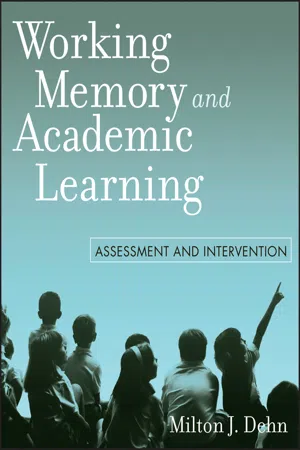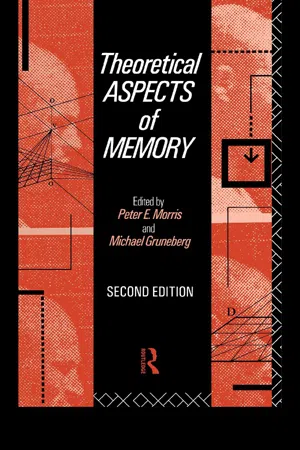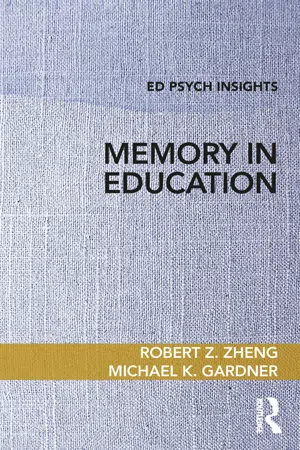Psychology
Baddeley
Baddeley is a prominent cognitive psychologist known for his influential model of working memory, which consists of the central executive, phonological loop, and visuospatial sketchpad. His model revolutionized the understanding of short-term memory and its role in cognitive processes. Baddeley's work has had a significant impact on the field of psychology, particularly in the study of memory and cognitive functioning.
Written by Perlego with AI-assistance
Related key terms
6 Key excerpts on "Baddeley"
- eBook - ePub
Working Memory and Academic Learning
Assessment and Intervention
- Milton J. Dehn(Author)
- 2011(Publication Date)
- Wiley(Publisher)
The two British psychologists developed the idea of a working memory within short-term memory. They defined working memory as “a system for the temporary holding and manipulation of information during the performance of a range of cognitive tasks such as comprehension, learning, and reasoning” (Baddeley, 1986, p. 34). As originally proposed, Baddeley and Hitch’s multifaceted model comprised three aspects of working memory—a phonological loop, a visuospatial sketchpad, and a central executive that controlled the other two subsystems, referred to as slave systems. In effect, Baddeley’s model is hierarchical, with the central executive as the top-level, domain-free factor that controls all the subcomponents. Apparently, Baddeley views the central executive as the essence of working memory; he usually refers to the two subsidiary systems as short-term memory components. Recently, Baddeley (2000) added another subcomponent—the episodic buffer (see Fig. 2.3). Over the past 3 decades a large number of studies have investigated Baddeley’s model. Overwhelmingly, the empirical evidence supports the division of working memory into modality-based short-term stores and a modality-free processing center where the work of working memory is conducted. FIGURE 2.3 Baddeley’s (2006) working memory model. The Phonological Loop The phonological loop, originally referred to as the articulatory loop, is a limited-capacity, speech-based store of verbal information (Baddeley, 1986, 2003a; Baddeley, Gathercole, & Papagno, 1998). Baddeley divides the loop into two subcomponents: a temporary, passive phonological input store and a subvocal, articulatory rehearsal process. Orally presented verbal information gains immediate, direct, and automatic access to the phonological loop, where it is briefly stored in phonological form (Hitch, 1990; Logie, 1996). The phonological loop is analogous to an audio tape recorder loop of specific length - eBook - ePub
Theoretical Aspects of Memory
Volume 2
- Michael Gruneberg, Peter E Morris(Authors)
- 2006(Publication Date)
- Routledge(Publisher)
(Baddeley et al. 1988). P.V. was unable to retain unfamiliar phonological material even temporarily, and so proved completely unable to learn new words. Once again, a short-term memory deficit resulted in a corresponding impairment of long-term learning for that domain of information. The case of E.L.D. is an important one. It provides a clear demonstration that, despite theoretical debates and uncertainties about how best to characterize the mechanisms and processes embodied in the sketchpad, it is a component of working memory which fulfils many useful functions in everyday life. Learning about new visual events is an ability which makes the human race particularly responsive to changes in the environment. The present evidence suggests that, without the sketchpad, our adaptability would be significantly reduced. THE CENTRAL EXECUTIVE Since Baddeley and Hitch (1974) first introduced the concept of the central executive, many different functions have been ascribed to the most complex and powerful component of the working memory model. It has been suggested that the central executive is involved in regulatory and control activities. Amongst these activities feature the control of attention and action, the regulation of the flow of information through components of the working memory system, and the retrieval of information from long-term memory. More generally, the central executive has been suggested to house consciousness. The central executive is also believed to possess both storage and processing capabilities that are fuelled by limited capacity processing resources. These resources are general purpose in nature, and so can be flexibly deployed in order to respond to a wide range of different informationprocessing requirements - eBook - ePub
- Robert Z. Zheng, Michael K. Gardner(Authors)
- 2019(Publication Date)
- Routledge(Publisher)
depth of processing model. According to these researchers, what determined memory was how deeply information was processed. If information was processed in a shallow fashion—for instance, attention was directed on the typeface in which words were presented—little would be remembered after a short time. However, if information was processed deeply—for instance, attention was placed on the semantics (or meaning) of presented words—a great deal would be remembered. Experimental results supported their conjecture: Focusing on meaning produced better recall. However, the level at which information was processed was never defined in a precise, independent way. The model simply stressed that what we do with to-be-learned material will play a critical role in our memory for it.Baddeley and Hitch’s Working Memory Model
In 1974, Alan Baddeley and Graham Hitch provided a new model of short-term memory, which they called “working memory” (see Figure 2.2 ).13 ,14 ,15The original working memory model consisted of a central executive linked to two independent slave subsystems: the phonological loop and the visuo-spatial sketchpad. In the working memory model, there was a much greater emphasis on the processing of information. The central executive allocates attention to the slave subsystems and coordinates the operation of working memory. The individual slave subsystems are tailored specifically to verbal material and visual material, respectively.Figure 2.2 Model of Working MemoryThere are some interesting research results that support the validity of the individual slave subsystems. With regard to the phonological loop, there are four empirical sources of support. The phonological similarity effect shows that short-term memory of phonologically similar items (e.g., PGTVCD) will be harder than phonologically dissimilar items (e.g., RHXKWY). This occurs because the phonological loop is based on phonological coding of information, and phonologically similar items have similar codes that are easier to confuse. The unattended speech effect shows that when participants are asked to immediately recall visually presented digits, speech and speech-like sounds (which participants are to ignore) interfere with digit recall. This is because the digits are converted to their names and stored in the phonological loop. Speech sounds enter the loop and interfere with the participant’s ability to rehearse the digits. The word length effect states that the number of words that can be held in short-term memory is related to the length of the words (i.e., the number of syllables they contain). Memory span appears to represent the number of words you can utter in about 2 seconds. Articulatory suppression effect - eBook - ePub
- Timothy J Perfect, D Stephen Lindsay(Authors)
- 2013(Publication Date)
- SAGE Publications Ltd(Publisher)
These examples show how the concept of working memory has been applied to education. This research has focused on the central executive and phonological loop components of Baddeley’s model. It has shown the importance of processing and storage capacity for general attainment, and the specific role of verbal short-term memory in language learning. Similar findings have been obtained in educational settings, using school tests as outcome measures, and in the laboratory. Gathercole and Alloway’s research shows how the working model provides a useful framework for classifying the cluster of problems experienced by children who struggle to keep track in classroom settings, and suggests solutions to those problems.MENTAL IMAGERY AND PSYCHOPATHOLOGYThe working memory model has been applied to problems of psychopathology. This research has focused more on the visuospatial sketchpad than on the phonological loop and central executive. Visuospatial working memory is interesting in clinical psychology because it supports visual imagery (Baddeley, 1986; Baddeley & Andrade, 2000; Logie, Zucco, & Baddeley, 1990) and visual imagery plays a key role in diverse clinical disorders (Holmes & Mathews, 2010). Post-traumatic stress disorder or PTSD is an important example of imagery contributing to the development and maintenance of a disorder, with patients experiencing vivid and intrusive imagery in the form of “flashbacks” to the traumatic event (e.g., Holmes, Grey, & Young, 2005), but imagery is prominent in other disorders too. People with social anxiety typically imagine themselves failing in public situations (Hirsch, Meynen, & Clark, 2004); those with spider phobia imagine fear-inducing encounters with spiders (Pratt, Cooper, & Hackmann, 2004); while those with health anxiety imagine illness and its consequences (Muse, McManus, Hackmann, Williams, & Williams, 2010).Imagery in clinical disorders is frequently multisensory. For example, in a study of craving in alcohol dependence by Kavanagh, May, and Andrade (2009), respondents pictured themselves drinking, imagined the taste and smell of their favourite drink, and imagined the sensation of swallowing alcohol, reporting an average of 2.3 sensory modalities in their imagery. However, experimental research on imagery in clinical disorders has focused on visual imagery, for several reasons. One is to make use of the working memory model as a framework to guide study design. Although Baddeley speculated that there might be temporary storage systems like the phonological loop and visuospatial sketchpad for information in other modalities, this possibility has received little research attention with the exception of a small amount of research on short-term memory for olfactory information (e.g., Andrade & Donaldson, 2007; White, 1998). A second reason is that visual imagery is very commonly reported whereas other modalities may be more specific to particular situations. For example, Lilley, Andrade, Turpin, Sabin-Farrell, and Holmes (2009) interviewed patients awaiting treatment for posttraumatic stress symptoms and found that most images, for most patients, were predominantly visual. Similarly, visual imagery is reported in craving across a wide range of substances and activities, but other modalities vary, so smokers report imagining the taste and smell of cigarettes whereas hockey players imagine the sound and bodily feel of playing hockey when they are craving their favourite sport (May, Andrade, Kavanagh, & Penfound, 2008). However, it is the experience of visual imagery that most strongly predicts craving strength, whether for alcohol (Kavanagh et al., 2009) or for sport (May et al., 2008). - eBook - ePub
- Alan Baddeley, Michael W. Eysenck, Michael C. Anderson(Authors)
- 2020(Publication Date)
- Routledge(Publisher)
Given the predictive power of complex span measures, there is great interest in understanding why they are successful in predicting such a wide range of cognitive activities. If we could identify the task component underpinning complex span, this might provide a deeper understanding of both working memory and intelligence. Attempts to develop a theory of working memory based on individual differences typically involve breaking working memory performance down into a number of more basic components, devising tasks that aim to tap these components, and then examining the extent to which each of these is able to predict performance on tests of reasoning, intelligence, or academic performance. Part of this process of analysis involves studying the extent to which particular tasks are related to each other, in ways that might suggest the nature of the underlying structure of the memory and processing systems involved.Happily, there tends to be broad agreement, with most analyses stressing the importance of an attentionally based control system, analogous to the central executive within the multicomponent working memory model. This tends to be strongly involved in complex tasks, with a smaller contribution from two or more components that appear to be responsible for the simple storage of verbal and visuo-spatial material, respectively (Engle et al., 1999; Gathercole, Pickering, Ambridge, & Wearing, 2004; Miyake, Friedman, Rettinger, Shah, & Hegarty, 2001). Again, this broadly resembles the structure proposed by the Baddeley and Hitch model. Most theories of working memory focus on the executive component, often simply attributing the STM functions to relatively unspecified “activation of LTM,” although the use of active verbal rehearsal is typically accepted as a source of temporary storage.Although most theories derived from the study of individual differences have proved to be broadly compatible with the multicomponent model, this resemblance is not always obvious. Nelson Cowan’s influential approach to working memory is a good example of a conflict that, in my own view, is more apparent than real (Baddeley, 2007, 2012; Cowan, 2001, 2005). - eBook - ePub
Understanding How We Learn
A Visual Guide
- Yana Weinstein, Megan Sumeracki, Oliver Caviglioli(Authors)
- 2018(Publication Date)
- Routledge(Publisher)
Cognitive psychologists have attempted to describe the processes involved in attention through a model called “working memory.” What do we mean by a model? A cognitive model can be thought of as a framework that defines various different processes that go on in the mind. In this particular case, it is a model that describes our ability to hold information for a short time, manipulate it, send it to/from long-term memory, and it can help us switch between tasks (though not particularly efficiently, as you read above). In particular, cognitive psychologists are interested in three key processes that they believe define working memory: the phonological loop, the visuospatial sketchpad, and the central executive (Baddeley & Hitch, 1974; Baddeley, 2003).The phonological loop stores and also rehearses verbal/auditory information. “Rehearsal” is essentially just repeating things over and over in your head so that you can remember it for a little while. It’s a way of getting around the short time span of short-term memory, and you probably do this without realizing. Imagine you are on your smartphone looking up a phone number. But annoyingly, when you get to the number you can’t just tap it to make the call because it’s not in the right format (it’s not a clickable link). Instead, you have to remember the number while you switch from your browser app to your phone app and then type in the number. In order to hold the number in your mind, you start reciting it subvocally (in your head), “555 6792, 555 6792, 555 6792” until you’re finally able to type it in. When you’re reciting in this example, you’re using your phonological loop.If your phonological loop is busy doing something else, though, it won’t help you retain information. What if I asked you to remember that phone number while repeating “the-the-the” out loud? What would happen is that you would have a harder time remembering the number, because your phonological loop was busy with the noise of “the-the-the” and so could not effectively rehearse the numbers you were trying to remember.The visuospatial sketchpad, on the other hand, helps you store visual information and plan using visual imagery. The visuospatial sketchpad enables you to create mental maps and spatial images. For example, imagine I asked you how you get from your bedroom to your kitchen. You might answer this question by picturing yourself walking through your house from one room to the other. This imagination process is thought to utilize the visuospatial sketchpad.
Learn about this page
Index pages curate the most relevant extracts from our library of academic textbooks. They’ve been created using an in-house natural language model (NLM), each adding context and meaning to key research topics.





